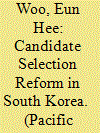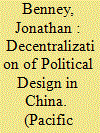|
|
|
Sort Order |
|
|
|
Items / Page
|
|
|
|
|
|
|
| Srl | Item |
| 1 |
ID:
175592


|
|
|
|
|
| Summary/Abstract |
This paper analyzes how democratization has affected the dynamics of candidate selection in South Korea. After democratization in the late 1980s, it was expected that intra-party democracy would follow. In response to increasing public demand, the major parties adopted primary systems in the early 2000s. Nonetheless, most candidates for the legislature are still nominated by a small number of central party elites without additional ballots in the local branches. To explain the persistence of the exclusive, centralized features of candidate selection, I highlight the limited impact democratization has had on the political environment in which parties operate. More specifically, since democratization ended in a compromise among a small number of party leaders, South Korea retained much of the political legacy from authoritarian times, such an electoral system advantageous to the major parties and legal provisions restricting electoral campaigns, party activities, and political participation. The continuation of these political institutions makes radical candidate selection reform highly unlikely as the party elites have no incentive to expand and decentralize the selection process. Without significant changes to the political institutions at the national level, the dominance of the central party elite over the final outcome of candidate selection looks likely to continue for the foreseeable future.
|
|
|
|
|
|
|
|
|
|
|
|
|
|
|
|
| 2 |
ID:
175591


|
|
|
|
|
| Summary/Abstract |
Political posters, banners, and similar objects are extremely common in China. This article uses political design from contemporary China, particularly emphasising the government’s Chinese Dream campaign, to analyze what at first appears to be a paradox. The subjects of the campaigns and the language they use are mandated by the central government and promoted through central and local publicity departments. But the graphic aspects of these campaigns, such as the choice of colours, images, layout, and typeface, are much less strictly controlled, and are decided by local governments or authorities. This makes political design in China decentralized. Decentralized design is inconsistent with the principles of global marketing and with the PRC’s reliance on set forms of political discourse, both of which rely on the assumption that uniformity will lead to more effective communication of messages and persuasion of the public. Evidence from local design campaigns indeed shows that Chinese political posters are often designed hastily and without expertise, resulting in strange and unpersuasive images. Despite this, this article shows that decentralized design is not paradoxical. This is largely because the Chinese party-state uses propaganda as a method of “signalling” its overall power, more than as a tool of indoctrination or persuasion about particular topics. The central government’s reliance on incentives and metrics to regulate local authorities also means that the production of propaganda is also a means by which local governments can signal their loyalty to the Centre.
|
|
|
|
|
|
|
|
|
|
|
|
|
|
|
|
| 3 |
ID:
175593


|
|
|
|
|
| Summary/Abstract |
Singapore’s 2020 general election was held amidst the country’s most serious public health and economic crises in the country’s history. Despite expectations that these parallel crises would precipitate a flight to safety and result in a strong performance by the dominant People’s Action Party (PAP), the ruling party received its third lowest popular vote share (61.2%) and lowest ever seat share (89.2%) since independence. This article engages explanations for the unexpected results and argues that the vote swing against the PAP was enabled by a hitherto largely overlooked factor: the 2020 election included two opposition parties that could credibly compete with the PAP on the valence considerations that drive voting behaviour in Singapore, giving voters a perceived safe alternative to the PAP at the constituency level. Quantitative tests support the notion that party credibility—rather than demographic factors, incumbency advantages, Group Representation Constituencies, or assessments of the PAP’s fourth generation leaders—best explain variation in the vote swing against the PAP. Ultimately, the results suggest that the PAP’s monopoly on party credibility is no longer assured, thus portending greater opposition competitiveness and pressure against the PAP in future elections. Nonetheless, the PAP’s dominance remains intact and there is little evidence of a general appetite among the electorate for a non-PAP government, suggesting the likelihood of smaller course corrections rather than major steps towards democratization in the coming years.
|
|
|
|
|
|
|
|
|
|
|
|
|
|
|
|
|
|
|
|
|